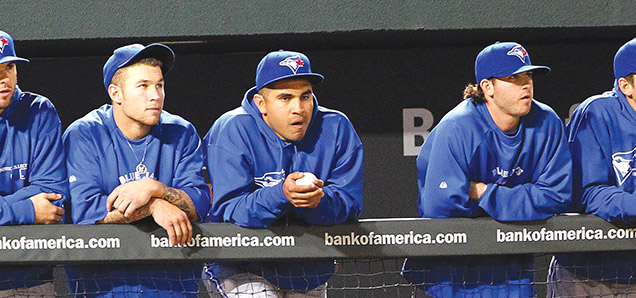A beginner's guide to the fantasy baseball galaxy
 CREDIT: "TORONTO BLUE JAYS" BY KEITH ALLISON ON FLICKR (CC BY-SA 2.0)
CREDIT: "TORONTO BLUE JAYS" BY KEITH ALLISON ON FLICKR (CC BY-SA 2.0)Avoid disappointment and choose players from other teams - not all Jays.
OK, so after a lot of peer pressure, you’ve decided to join a friend’s fantasy baseball league. You’re an avid baseball fan, but you haven’t got a clue on how this whole fantasy baseball thing works.
Well, don’t worry my friend. We’ve got your back.
Listed below is your beginner’s guide to the world of fantasy baseball.
Which format? Rotisserie vs. Head-to-Head
The first step in approaching fantasy baseball is understanding the format for your league. The two most common types are rotisserie and head-to-head.
In rotisserie leagues, stats are accumulated throughout the season. Your total score in each category is ranked against every team in the league and you are given a particular number of points for each category depending on where you fall in the standings. If your league has 12 teams and you rank first in batting average, you get 12 points. If you are last in homeruns you receive one point.
In head-to-head leagues you are matched up against a different opponent each week. You each accumulate stats in designated categories and whoever has the most wins that category. By the end of the week, if you have won the most categories, you win your matchup. The final four weeks of the regular season are designated as head-to-head playoffs where the top eight teams enter a playoff elimination bracket. Whatever team finishes the bracket undefeated is declared the winner.
No matter which format you’re playing in, you always have to plan around the stats.
Knowing the scoring categories
The next step in understanding your fantasy baseball league is knowing the scoring system.
The most common set-up for a fantasy baseball league is called a standard 5x5. This set up tracks batting statistics such as Runs (R), Homeruns (HR), Runs Batted-In (RBI), Batting Average (AVG) and Stolen Bases (SB). The standard pitching categories are Wins, Saves (SV), Strikeouts (K), Earned Run Average (ERA) and Walks plus Hits divided by Innings Pitched (WHIP).
One of the most addictive parts of fantasy baseball is stat-checking. During every game, the players you designate to be starters accumulate stats in these categories. At the end of every day, you can check in on your team to see how they have done. If you are unhappy with certain players, you have the option of benching them or outright dropping them.
But be careful. Once you drop a player, you might not get them back.
Plan for the draft
The final and most exciting step in getting ready for your fantasy baseball league is preparing for the draft.
One way to approach your draft is to create cheat sheets or a ranking of your top five most wanted players at each position. As you work your way through the draft, refer to your list and see if any of your most wanted players are still available.
Final tips
When assembling a fantasy baseball team, don’t be afraid to pick players you don’t like and throw your own personal biases out the window. If you draft a team full of Toronto Blue Jays, you’re going to end up at the bottom of the standings. This isn’t because the Jays are destined for a bad season, it’s because you didn’t diversify your line-up enough.
Draft hitting early and often. The early rounds of a draft is all about managing risk and securing the most stable production for your team. In fantasy baseball, the pitching position is the one that is most susceptible to significant injury and risk. Hitters, on the other hand, generally put up the same numbers every season. There is simply a better guarantee on your investment when it comes to drafting hitters in the early rounds compared to pitchers.
Now you’re ready to embark on your journey towards fantasy baseball glory.
Go on and get your cheat sheets ready and let the games begin.













